Apple's Mac Pro - Upgrading CPUs, Memory & Running XP
by Anand Lal Shimpi on September 12, 2006 1:51 AM EST- Posted in
- Mac
Next we had to remove the fan assembly, which we did by first removing two of the hard drive sleds so we could gain access to the lone screw that holds the fan assembly in place. Then, with a flexible putty knife we pulled the edge of the assembly away from the case and attempted to pull it out. The fan assembly will pull straight out, although we've found that it's a very tight fit and wiggling sometimes helps as you pull it out.
The fan assembly is made out of plastic so be careful as you're doing this; you'll want to put pressure on the less flimsy parts of the assembly to avoid snapping/cracking anything. Also be careful not to put pressure on the heatsinks as the aluminum is very thin and will bend very easily.
With the fan assembly out take a moment to marvel at how large and heavy it is, and then put it aside as we need to get one more thing out of the way before we can unscrew the heatsinks. If you can get the memory cage out then this next step isn't necessary, but if you're like us and can't get the thing out then this next step will make removing the heatsinks a lot easier.
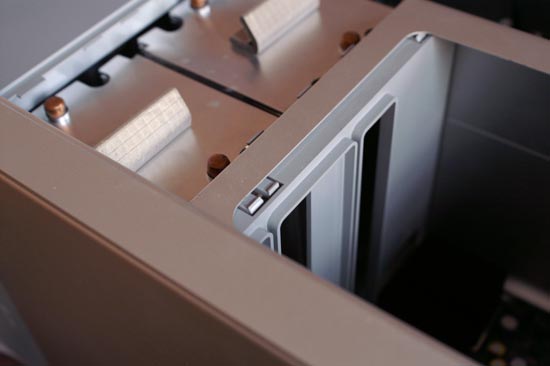
The plastic guard, pulled out slightly to expose the latches - Click to Enlarge
There's a plastic piece that sits in the left side of the memory cage; it's what the CPU heatsink cover latches on to on this side and it's also what helps the memory risers guide into place. This plastic piece can be removed fairly easily as it just latches into the memory cage itself, so break out the putty knife and let's get to it.
All you need to do is unlatch the plastic guard from the memory cage by sliding your putty knife between the cage and the guard. As you unlatch the plastic guard start pulling it away from the CPUs and eventually you'll get it off completely. Patience pays off here as you don't want to break any of the latches.
With the plastic guard off, it's now infinitely easier to gain access to the screws that hold the heatsinks in place. Each heatsink is attached to the motherboard by four allen screws; simply remove them (in an opposite side/opposite corner pattern) using a very long screwdriver (or a small allen wrench). We didn't have an allen wrench that worked so we attached two extenders to our screwdriver to get down to the screws.
With all of the screws undone for the first heatsink (the allen screws don't come off completely, they remain attached to the heatsink) you have to disconnect the thermistor cable that runs from the heatsink to the motherboard. Be sure to do this before you remove the heatsink as you don't want to cause any accidental damage to the cable.
Finally you lift off the heatsink and set it aside, exposing the LGA-771 Xeon socket below. You can repeat the process for the second heatsink, also not forgetting to remove its thermistor cable (this one is actually beneath the memory cage) before pulling off the heatsink. With both heatsinks removed, it was time to swap processors.


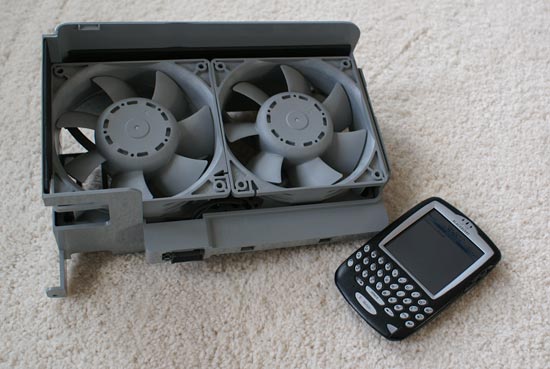
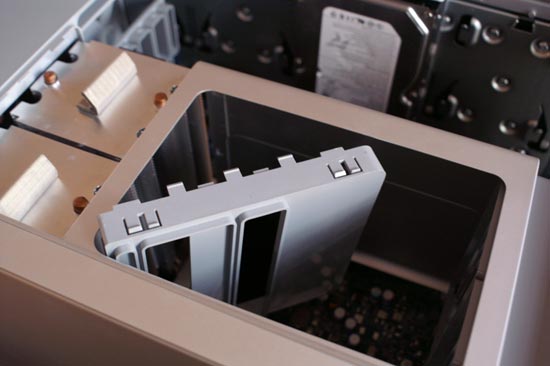
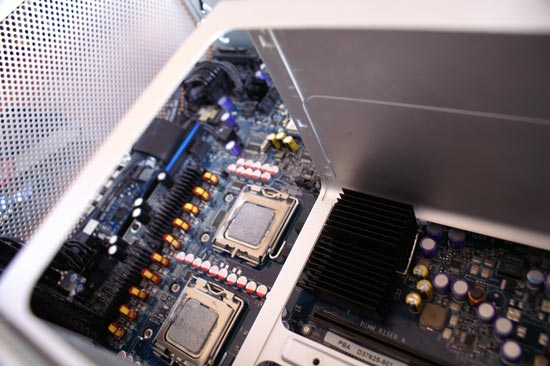
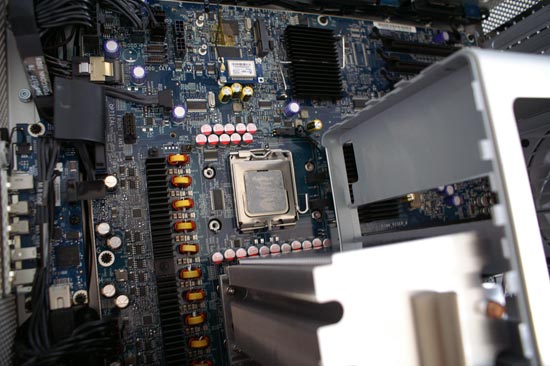
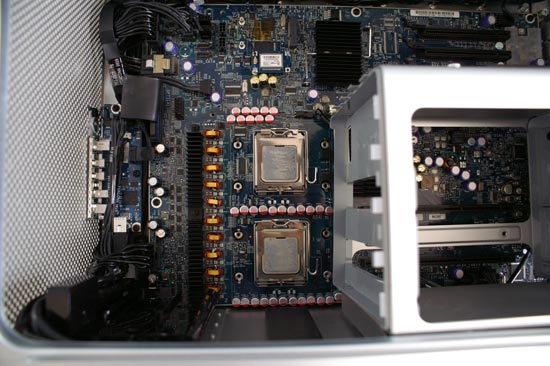








72 Comments
View All Comments
Mhorydyn - Saturday, September 23, 2006 - link
Hammong: I agree that I'd like to see some benchmarks done comparing gaming with 2 DIMMs and 4 DIMMs especially after seeing this: http://www.tomshardware.com/2006/06/26/xeon_woodcr...">http://www.tomshardware.com/2006/06/26/...#dual_vs...For those too lazy to check it out, it shows the 3.0 GHz Woodcrest (5160) scoring roughly 3800 MB/s for both the Integer and the Floating Point benchmarks using SiSoft Sandra 2007 (dual channel). Going to quad channel nets an increase of nearly 2000 MB/s (5740-ish).
hammong - Saturday, September 23, 2006 - link
Anand - I'd like to see these Windows XP benchmarks run again with 4 FB-DIMMS installed in the Mac Pro. As everybody is aware, the Mac Pro has 8 FB-DIMM slots, and is targeted at the high-memory workstation market. In order to take advanage of the 256-bit wide DDR2 memory bus on the Intel 5000x chipset, you need to populate the memory in 4- or 8-DIMM configurations.The Mac Pro, despite the gripe from some home builders, is a decent bargain in the Intel workstation market. Compare the system against a comparably equipped HP, IBM, or Dell professional workstation, and the cost difference is minimal. Yeah, you can slap a Tyan server motherboard in your case of choice and build a comparable system to spec, but you also provide your own drivers, warranty service, and can't run OSX without a hack. A business relying on OSX for productivity won't build their own - and the Mac Pro isn't targeted at the budget-conscious home PC user.
I see a lot of good comments here. Keep it going - and lets see that 4-DIMM vs. 2-DIMM comparison!
JAS - Friday, September 22, 2006 - link
Any findings since Apple posted the Mac Pro firmware update on 9/19/06?MasterH8r - Thursday, September 14, 2006 - link
quote: - It will cost far less to build that core 2 Duo system in the short term future as the typical market forces in the PC industry affect those prices while Apple historically keeps their flagship hardware prices elevated.Actually, Apple reduces their prices after their products have been available for a while. Just like everyone else. If Apple is currently selling these machines at a significantly lower price than comparably equiped machines from Dell, what makes you think they're going to suddenly jack their prices up in the 'short term future'?
Historically, Apple has charged a high premium for their hardware, but that has changed signifcantly in the last couple of years. I wouldn't say they have a price advantage, but they're not gouging people like they used to.
This is all moot anyway. A lot of people were able to justify the price premium because the one of the biggest advantages of owning a Mac stem from the tight integration of hardware and OS (they both come from the same place). That's not something you can get from another manufacturer. While it's true, that Windows has become an acceptable operating system of the last few years (and with the new features MS has stolen from OS X that will be included in Vista, I'm sure it will get better), it is still a third party OS on any machine it runs. It still has the uphill battle of working well on litterally thousands of different harware configurations.
muf - Tuesday, September 19, 2006 - link
It seems that there is a new problem that is affecting multiple users that needs to be seen and tested on one of these big sites.I just threw in 2 more gigs into my mac pro bringing the total to 3 gigs. 2x1 gig sticks and 2x 512meg sticks. Interesting thing is, windows only reports 2 gigs installed. I run sandra to test things and it reports 4 dimms installed in windows and quad channel memory mode is active. OSX reports 3 gigs correctly. Linux also only reports 2 gigs as well.
Someone on the official mac forums said that for some reason only 2 gigs is able to be seen by windows. There are quite a few people having this problem. Anand could you look into it and confirm with me?
spikespiegal - Wednesday, September 13, 2006 - link
>>>>>The linked story illuminates a fundamental disadvantage to Microsoft (trying to roll out Vista with some degree of backward/forward compatibility with the still sort-of-large universe of hardware subsetted as "Vista compatible")<<<<<So, because Apple has fewer 32-bit applications and drivers to run in 64 bit operating systems, it's an advantage? Neat logic - guess that means I'll be retiring my 64-bit Opteron machines running a half dozen virtual 2003 servers and migrate to Apple. NT 4.0 didnt' exactly treat 16-bit devices efficiently either, but it didn't keep the market from embracing Win98 with more enthusiasm.
I know more XP 64 users than 64-bit apple users. In fact, that ratio is like 100:1.
That same graphics lab I used to work it has to run OSX 10.3 and 10.4 on different boxes to maintain hardware compatibility with various printers. Their Win 2000 boxes run everything.
msanj0la - Thursday, September 14, 2006 - link
Quoting from the linked article,"Starting with Xcode 2.4, the OSX Universal binary format has been extended to support 32-bit and 64-bit for both PPC and Intel processors inside the same file, giving OSX quad universal binaries. Users don't have to choose between processor architectures nor 32-bit or 64-bit processors, either at the OS or application layers, it's all abstracted away from them - as it should be.
Note that the non-emulated support in OSX is for applications and drivers. 32-bit programs on Vista 64 need to work on WOW emulation to run in Vista, and 32-bit drivers are a no-no. Lack of driver support is the main reason Windows XP x64 hasn't been widely adopted, and why the Vista fudge will ensure hardware incompatibilities between the two Windows versions remain for sometime to come."
//end quote,
The kernel of something / anything I get from The Inquirer bit is that a user who needs/wants a shrink wrapped 64 bit OS, and for whatever reason can't / won't go Linux, seems to have compelling or at least intriguing redirect from Vista to Leopard (with or without option to boot XP).
I agree with everyone else who comments XP (and Win2K) are perfectly good platforms. I have no experience at all with 64 bit version of XP or lack of 64 bit drivers referenced in the Inquirer writeup, I figure someone who knows what they're doing can pick hardware known to have acceptable drivers before they build / buy / migrate existing system to XP64.
spikespiegal - Wednesday, September 13, 2006 - link
Yeah....we all know Windows has only just recently been a decent platform for graphics work (not). I recall back in the mid 90's when I was managing the digital dept at a local graphics lab, and how we were able to run film recorders, burners, printers, simultaneous sessions of photoshop, and a host of other network task *simultaneously* on NT 3.51 while our Mac OS7/8 boxes would routinely 'time bomb' while simply running Photoshop.Those of you Apple-heads raving about this new box haven't seen the benchmarks at the end of the article, and must not have converted your G4 cubes to terrariums yet. Boy, it looks the like a 3ghz Core 2 Duo in the benchmark tests held it's own against the Mac Pro, and even beat it in several tasks. Now I ask all of you how much you can build a 3ghz Core 2 Duo box for compared to the Mac Pro, and if you still think the housing market is in a boom cycle.
So, what I've learned from this article is:
- The new Mac Pro costs about the same as a similiar machine you could build yourself or buy from Dell.
- All of the above machines are inefficient given very few tasks other than brainless rendering programs and data compressors (Cough* bootleg DVD converters cough) can utilize more than one core at a time.
- A single Core 2 Duo at the same clock sits well against the Mac Pro, costs considerably less to build, and is far more practical for a power desktop user to use.
- It will cost far less to build that core 2 Duo system in the short term future as the typical market forces in the PC industry affect those prices while Apple historically keeps their flagship hardware prices elevated.
- Apple doesn't let you use a Core 2 Duo desktop, but instead offers an under powered mobile processor in the new iMac to keep Mac Pro users feeling superior (while simultaneously winking at their G5 userbase to make them feel like *they* are still superior over the "Intel junk")
- E-machine will be selling faster machines than the Mac Pro in less than a year for 1/3 the price. Don't flame me, just look at recent history in the PC industry.
- If I buy Windows XP or Vista, I can run it on any platform or hardware I want -vs- being forced to spend +$2500. That's why Anandtech ran the benchmarks with Windows XP and not OSX, but evaded that point.
msanj0la - Wednesday, September 13, 2006 - link
http://www.theinq.com/default.aspx?article=33666">64 Bit Leopard Knocks Spots off Vista
I'm surprised / intrigued by the cost comparisons discussed here, having always imagined Apple's business model has rested (and would likely always rest) on marketing to niche audiences willing to pay relatively large premiums for the hardware
The linked story illuminates a fundamental disadvantage to Microsoft (trying to roll out Vista with some degree of backward/forward compatibility with the still sort-of-large universe of hardware subsetted as "Vista compatible") - yes of course MS has tremendous resources and talent (but check the blogs of disgruntled MS insiders railing against quality and timeline for rolling out Vista and MS leadership in general) - this disadvantage bookends with giving credit to efforts / resources / talent / quality of strategy and execution Apple has leveraged in support of OSX Tiger (soon to be followed by Leopard)
So yeah, I think Apple + Intel combination sets up with reasonably good odds of picking up market share from Dell and Microsoft.
Side note, I have never owned a Mac, am sort of on the verge of a C2D build from parts, waiting on Kentsfield mostly for possible price effect on maybe the 6600 part, getting back to cost compares, overclocking a midrange or lower end C2D with carefully selected surrounding components might tilt the equation a bit, particularly for games, but I have to say, for someone who wants a turnkey deal that (paraphrasing Al Davis) "just runs, baby" Mac Pro, hmmmmm
Calin - Wednesday, September 13, 2006 - link
"Apple's business model has rested (and would likely always rest) on marketing to niche audiences willing to pay relatively large premiums for the hardware"There were times when the Microsoft's consumer operating systems were not good enough for some tasks, and also the software for such tasks was running mainly on the Apple's platform. There was a time when Desktop Publishing was made only on Macs, there was a time when video editing was made almost only on Macs, there was a time when... There were times when the software optimised to run on Mac ran faster than what you could have on PC, was much less crash-prone, and so on.
As of now, most of the software you find on Mac you can find on PC, with some limitations (like memory support for really great amounts of memory) Microsoft's consumer operating systems are stable enough, and the performance of the x86 ran circles around the Power architecture in older Macs. As a result, keeping high prices will only hurt Apple's market, and people that used a Mac will use a PC. Apple has nowhere to go now, as its market share would be cornered from all sides. Most of the "professional users" (I've seen this on a video editing computer in the days of the Pentium MMX) knows their program, and just a bit more. For them, having the wonderful Mac OS X interface or a command line interface has little effect, as long as their program runs nice, well and fast.